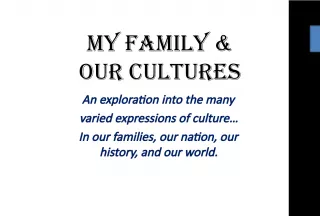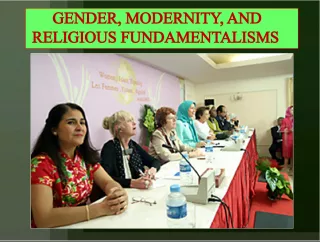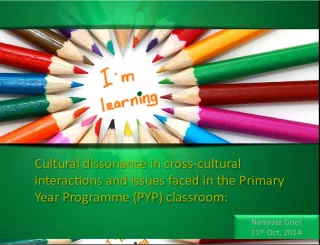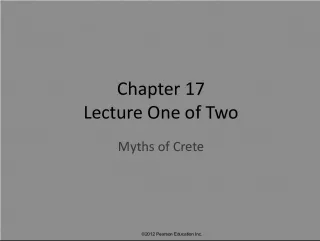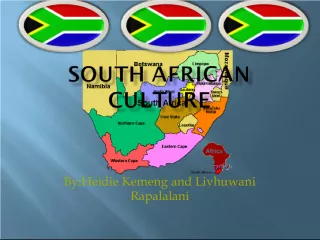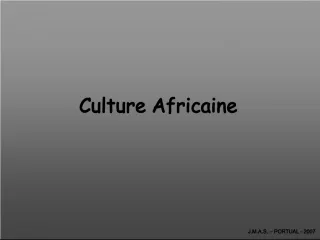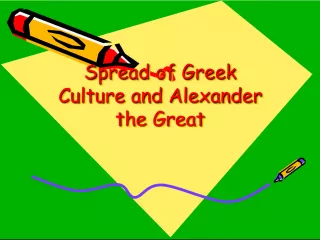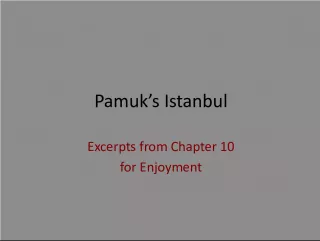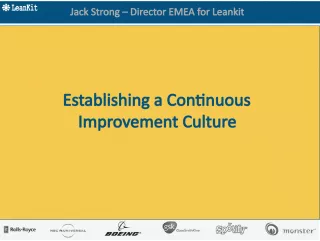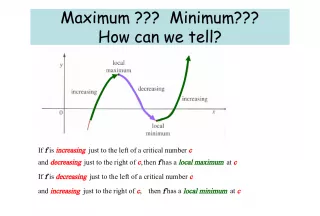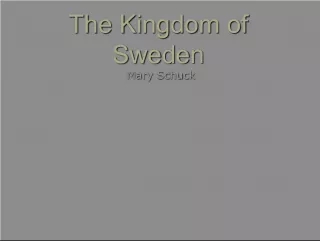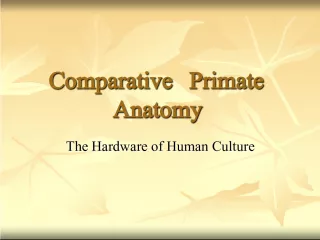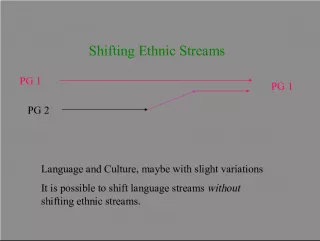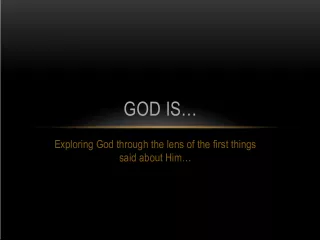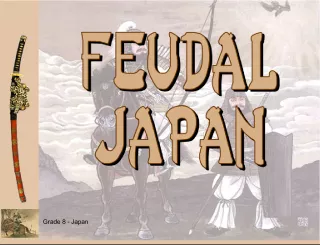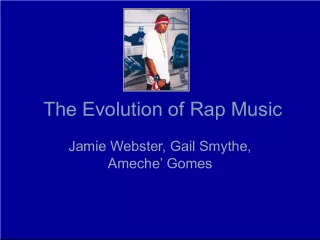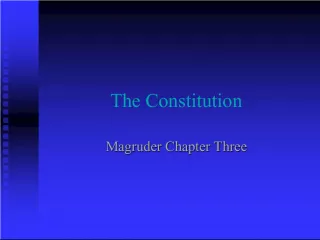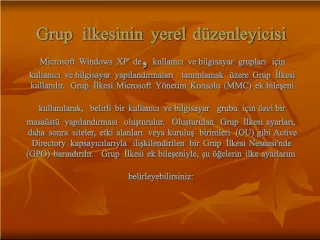Local Culture, Popular Culture, and Cultural Landscapes Chapter 4: Exploring Local and Popular Cultures
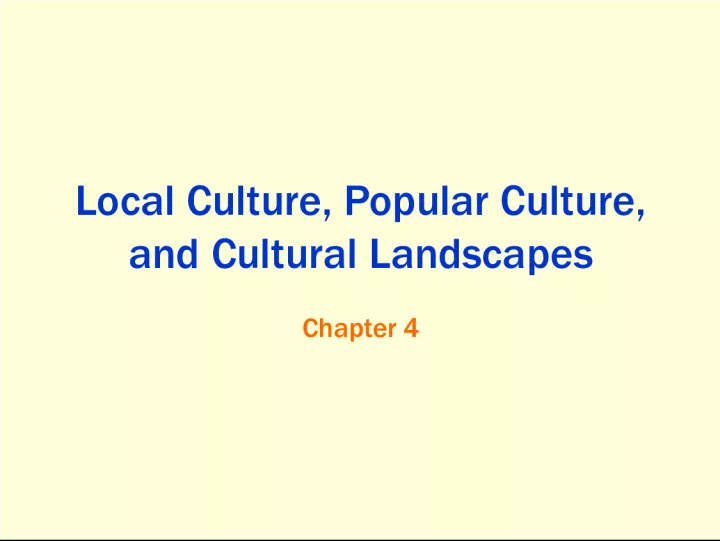

This chapter delves into the concept of local culture, which refers to a group of people living in a particular area
- Uploaded on | 2 Views
-
 oliver
oliver
About Local Culture, Popular Culture, and Cultural Landscapes Chapter 4: Exploring Local and Popular Cultures
PowerPoint presentation about 'Local Culture, Popular Culture, and Cultural Landscapes Chapter 4: Exploring Local and Popular Cultures'. This presentation describes the topic on This chapter delves into the concept of local culture, which refers to a group of people living in a particular area. The key topics included in this slideshow are . Download this presentation absolutely free.
Presentation Transcript
Slide1Local Culture, Popular Culture,and Cultural Landscapes Chapter 4
Slide2What are Local andPopular Cultures? Key Question:
Slide3Local Culture:A group of people in a particular place who see themselves as a collective or a community, who share experiences, customs, and traits, and who work to preserve those traits and customs in order to claim uniqueness and to distinguish themselves from others.
Slide4Hutterite Coloniesin North America Are the Hutterites an example of a local culture?
Slide5Why areHutterite colonies located where they are?
Slide6How do cultural traitsfrom local cultures become part of popular culture? Madonna wearing a red string Kabbalah bracelet.
Slide7Employing the concept of hierarchical diffusion,describe how you first became a “knower” of your favorite kind of music – where is its hearth, and how did it reach you?
Slide8How are Local CulturesSustained? Key Question:
Slide9Local cultures are sustained bymaintaining customs. Custom: a practice that a group of people routinely follows.
Slide10Material and Nonmaterial CultureMaterial Culture The things a group of people construct, such as art, houses, clothing, sports, dance, and food. Nonmaterial Culture The beliefs, practices, aesthetics, and values of a group of people.
Slide11littlesweden, usa (lindsborg, kansas): is the swedish Dala horse part ofmaterial or nonmaterial culture?
Slide12CommodificationHow are aspects of local culture (material, non- material, place) commodified? what is commodified? who commodifies it?
Slide13AuthenticityClaims of authenticity abound – how do consumers determine what experience/place is “authentic” and what is not?
Slide14In an age of globalization, wherepopular culture diffuses quickly, what do local cultures do to maintain their customs?
Slide15Local Cultures often have two goals:1. keeping other cultures out. (ie. create a boundary around itself) 2. keeping their own culture in. (ie. avoid cultural appropriation)
Slide16Rural Local Cultures• Migration into rural areas is less frequent. • Can better separate their culture from others and from popular culture. • Can define their own space. • Daily life my be defined by a shared economic activity.
Slide17Makah (Neah Bay, Washington)Why did the Makah reinstate the whale hunt?
Slide18Makah (Neah Bay, Washington)Why did the Makah reinstate the whale hunt? To reinvigorate the local culture.
Slide19Urban Local Cultures• Can create ethnic neighborhoods within cities. • Creates a space to practice customs. • Can cluster businesses, houses of worship, schools to support local culture. • Migration into ethnic neighborhoods can quickly change an ethnic neighborhood. For example: Williamsburg, NY, North End (Boston), MA
Slide20Think about your local community (yourcollege campus, your neighborhood, your town). Determine how your local community takes one aspect of popular culture and makes it your own.
Slide21Little Sweden, USA (Lindsborg, KS)Why did the residents of Lindsborg define it as a Swedish place?
Slide22Little Sweden, USA (Lindsborg, KS)Why did the residents of Lindsborg define it as a Swedish place? neolocalism: seeking out the regional culture and reinvigorating it in response to the uncertainty of the modern world.
Slide23runners of the nyc marathon run through williamsburg, (Brooklyn), NY
Slide24Popular Culture:A wide-ranging group of heterogeneous people, who stretch across identities and across the world, and who embrace cultural traits such as music, dance, clothing, and food preference that change frequently and are ubiquitous on the cultural landscape.
Slide25How are hearths ofpopular culture traits established? • Typically begins with an idea/good and contagious diffusion. • Companies can create/manufacture popular culture. (ie. MTV) • Individuals can create/manufacture popular culture. (ie. Tony Hawk)
Slide26How is PopularCulture Diffused? Key Question:
Slide27How do cultural traits diffuse?• Hearth : the point of origin of a cultural trait . Expansion Diffusion Contagious diffusion • Hierarchical diffusion • Stimulation Diffusion • Relocation Diffusion
Slide28The hearth of Phish concerts is in the northeastern United States, near where the band began in Vermont.
Slide29With Distance Decay , the likelihood of diffusion decreases as time and distance from the hearth increases. With Time-Space Compression , the likelihood of diffusion depends upon the connectedness among places. Which applies more to popular culture?
Slide30Why are popular culturetraits usually diffused hierarchically? How is fashion in popular culture an example of hierarchical diffusion?
Slide31How do culturaltraits diffuse? Hearth : the point of origin of a cultural trait . Expansion Diffusion Contagious diffusion Hierarchical diffusion Stimulation Diffusion Relocation Diffusion
Slide32What is the last place you went to or the lastproduct you purchased that claimed to be “authentic?” What are the challenges of defending the authenticity of this place or product while refuting the authenticity of other similar places or products?
Slide33How can Local and PopularCultures be seen in the Cultural Landscape? Key Question:
Slide34What role does place play inmaintaining customs? By defining a place (a town or a neighborhood) or a space for a short amount of time (an annual festival) as representing a culture and its values, members of a local culture can maintain (or reestablish) its customs and reinforce its beliefs.
Slide35Cultural LandscapeThe visible human imprint on the landscape. - How have people changed the landscape? - What buildings, statues, and so forth have they erected? - How do landscapes reflect the values of a culture?
Slide36placelessness: the loss of uniqueness in a culturallandscape – one place looks like the next.
Slide37Convergence of Cultural Landscapes:• Diffusion of architectural forms and planning ideas around the world.
Slide38•The widespread distribution of businesses and products creates distinctive landscape stamps around the world. Convergence of Cultural Landscapes:
Slide39•Borrowing of idealized landscape images blurs place distinctiveness. Convergence of Cultural Landscapes:
Slide40House Types• Kniffen’s traditional American house types: New England Mid-Atlantic Southern Tidewater
Slide42Focus on the cultural landscape of your collegecampus. Thing about the concept of placelessness. Determine whether your campus is a “placeless place” or if the cultural landscape of your college reflects the unique identity of the place. Imagine you are hired to build a new student union on your campus. How could you design the building to reflect the uniqueness of your college?
